|
|
Release Notes
Gaelic for 'Golden Salmon', Bradan Orach is a classic, easy drinking Speyside malt, matured exclusively in ex-bourbon casks.
The bourbon wood gives the malt a wonderful complexity and depth, without making it overly challenging. Like the 10 Year Old it is very easy to drink and a great way to get to know Speyburn. strength="40"
Speyburn
Speyburn BO? Hm...
Yours Truly
3rd Party Tasting Notes
Colour: Bright, golden-amber colour
Nose: Green apples, honey, lemon and floral vanilla spices
Taste: Subtle and delicate yet also packs a rustic punch with its smoke and peat
Nose: Green apples, honey, lemon and floral vanilla spices
Taste: Subtle and delicate yet also packs a rustic punch with its smoke and peat
Speyburn
Decent whisky. It was a good value at $15. Gentle fruitiness in the aroma. Buttery. Heather, bananas, apricots. A bit sweet and simple but pleasant enough.
popery, Connosr.com
Nose: Fresh clothes on the line, citrus fruit, almost not distinguished as a Whisky, quite wine like.
Taste: Cherry, fruity and fresh, mellow but nothing complex.
Finish: Short and satisfying definitely worth another glass.
Taste: Cherry, fruity and fresh, mellow but nothing complex.
Finish: Short and satisfying definitely worth another glass.
Nicola, Whiskyboys.com
Nose: Very fresh and floral, a big whiff of sweetness.
Taste: Smooth and mellow, a little malty, fruit and heather, but not too much happening in my glass.
Finish: Short to medium finish, leaves a little tingle on the sides of your tongue.
Taste: Smooth and mellow, a little malty, fruit and heather, but not too much happening in my glass.
Finish: Short to medium finish, leaves a little tingle on the sides of your tongue.
Jim, Whiskyboys.com
The Distillery: Speyburn
| Established: 1897 |
| Silent since: False |
| Address: Rothes, Charlestown of Aberlour, Banffshire, AB38 7AG, Scotland, UK |
| → website |
2001 - Inver House is obtained by Pacific Spirits (a subsidiary of the Asian Great Oriole Group).
The Speyburn distillery started production in 1897 - but only barely... The proprietors were keen to start the distillation in the year of Queen Victoria"s diamond jubilee, but they almost didn"t make it. Production was scheduled to start on November 1, but the owners didn"t manage to get the stills running before the middle of December of that year.
Speyburn distillery has a traditional rake mash tun that holds 25,000 litres of wort. They use Douglas Fir wash backs and the still room houses a single pair of stills, just like when the distillery was built. Alcohol vapours are condensed with more than a hundred meters of copper pipe in the traditional cold water worm tubs.
Well over half of the Speyburn malt whisky is transported away to be filled at the Airdrie headquarters of Inver House. The remaining spirit is filled into cask and stored in one of the two warehouses at the distillery.
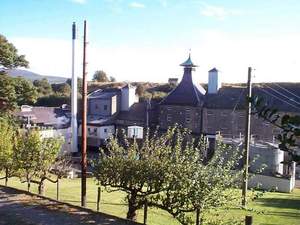
Speyburn was transferred to SMD (Scottish Malt Distillers, a predecessor of Diageo) in 1962 and the drum maltings at the distillery - once a novelty in the whisky industry - were closed six years later. Inver House Distillers bought Speyburn in 1991 or 1992, three years after they bought Knockdhu and half a decade before they bought Balblair, Balmenach and Old Pulteney. Inver House were themselves taken over by Pacific Spirits from the Great Oriole Group from Asia.
The 10 years old official bottling depicted at the left was the primary expression for many years. According to the Malt Whisky Yearbook 2006 only some 10,000 bottles of the Speyburn single malt were sold annually in the UK, but a far greater number was shipped to the U.S.A. each year; a whopping 350,000 bottles. At the time Speyburn was amongst the biggest selling single malt whiskies in the USA - it was in the top 10. With a measly 10,000 bottles it"s definitely not in the top ten in the United Kingdom, and if the situation in Holland is anything to go by it"s a fairly obscure brand in Europe as well. The good news is that it"s an affordable dram; during the 1990"s there were many good alternatives for a few more Euro"s, but these days not so much anymore...
Like many other distilleries in Scotland, Speyburn was designed by Charles Doig. The required investment was 17,000 pounds - a modest price for a distillery on a prime location (it"s located in the Rothes Glen) that was equipped with the latest innovations. For example, Speyburn was the first distillery in Scotland with a drum maltings. Neighbouring Glen Grant distillery and Saint Magdalene (Lowlands) soon followed.
The company behind the launch of Speyburn in 1897 was John Hopkins & Co. - an enterprise of the brothers John and Edward Hopkins and their nephew Edward Broughton. Speyburn wasn"t their first distillery; in 1890 they had already acquired the Tobermory distillery on the island Mull. In 1916 DCL (Distillers Company Limited) acquired the company and its distilleries. Like many other Scottish whisky distilleries Speyburn didn"t produce whisky during part of the first World War. After peace broke out production was resumed, but in 1930 production was ceased again - this time until 1934. Then WWII caused another pause in the production of malt whisky, but after the end of the second world war production at Speyburn continued uninterrupted until the present day.
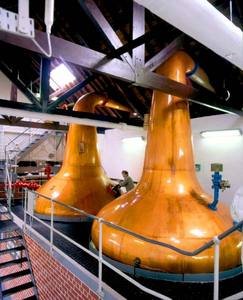
Speyburn is the only distillery to use the particularly soft Speyside water from the Granty Burn - depicted at the right - for the production of its malt whisky. The Granty Burn that supplies Speyburn with its water is one of the major tributaries to the River Spey.
In the new Millenium
2006 - Pacafic Spirits UK is taken over by International Beverage Holdings.
2008 - A new stainless steel mash tun replaces the old cast iron mash tun.
Trivia:
- Some locals still refer to the distillery as "The Gibbet" because of its location near the ancient "Cnock na Croiche" or "Hill of the Gibbet". The word "gibbet" was originally synonymous with gallows, but in later use could also mean an upright post with a projecting arm from which the bodies of criminals were hung in chains or irons after execution.
- One of the reasons for the installation of the drum maltings (a mechanical, steam-driven malting system with rotating cylinders) in 1897 was the relatively compact design - less space was necessary than conventional floor maltings. Most of the other buildings were built to make the best use of the available space as well - there are quite a few slopes in the surroundings of Speyburn distillery. Charles Doig designed the distillery based on height instead of surface. For example, the cask warehouses occupy 2 or 3 levels. The entire Speyburn distillery (which had an annual capacity of 100,000 Gallons of alcohol at the time it was built) occupies no more than three acres.
- The proprietors were in a rush to get distillation started; they wanted the first fillings to bear 1897 - the year of Queen Victoria"s Diamond Jubilee . They had scheduled production to start on 1 November 1897 but it seems that even in those days the estimates of contractors were overly enthusiastic; the stills were heated for the first time on 15 December 1897 amidst a snow storm. The owners were so eager to get the production started that they began distillation even though the doors and windows of the still house were not even installed yet. Despite the harsh conditions the workers managed to fill at least one butt of Speyburn single malt whisky during the year of Queen Victoria"s Diamond Jubilee. (Maybe more whisky was produced, but just one cask was bonded.)
- Speyburn is sometimes described as the most photographed distillery in Scotland. I"m not quite sure if and how this is measured though...
- Most of the Speyburn malt whisky that is produced is used for blends.
- The first manager of Speyburn distillery was one Mr. John Smith. He managed to hang on to the job for 31 years.
- In 1962 Speyburn"s two stills were both converted to internal heating by steam (from a coal-fired boiler).
- Between 1939 to 1947 the Speyburn distillery was temporarily closed when it was used to house two Scottish Artillery regiments during the second world war.
from Malt Madness
The Owner: Inver House Distillers
| Established: 1964 |
| Silent since: False |
| Address: Towers Road, Airdrie, ML6 8P, Scotland, UK |
| → website |
Being part of a larger group ensures the company"s continued success in an increasingly competitive market place.
Inver House is also committed to the training and development of its employees and in 1999 received the coveted Investors in People accreditation.
In October 2001, Inver House entered a new chapter when it was purchased by Pacific Spirit (U.K.) Ltd, now International Beverage Holdings Limited (InterBev) - the international arm of Asia"s leading drinks business, the Thai Beverage Public Company Limited (ThaiBev) with an outstanding portfolio of beverage alcohol brands across spirits, wine and beer categories.
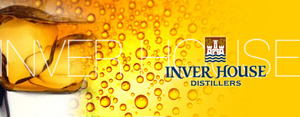
The substantial warehousing, blending and office facilities all remained, and do so to this day, as do the state of the art Gin, Vodka and Cream Production Facilities.
However, following the takeover by the management team in 1988, and the revival of the Scotch Whisky industry, Inver House Distillers purchased 5 highly regarded malt distilleries over a period of 9 years. Since then Inver House has gone from strength to strength in its commitment to a worldwide market. This continued commitment was recognised in 1992 with the granting of the Queen"s Award for Export Achievement.
Inver House Distillers was established in 1964 as a subsidiary of the American company, Publicker Industries. In the 1970"s the Scotch Whisky industry faced competition from other spirit categoreis and coupled with the death of its American Chairman, Publicker Industries did not focus its business interests in its Scottish subsidiaries. As a result of this, the malt and grain distilleries at the Scottish site in Airdrie became surplus to requirements and were closed in 1985 and 1986.
Trivia:
- IHD currently owns 5 distilleries: Pulteney, Balblair, Knockdhu (including anCnoc Single Malts), Speyburn and Balmenach.
- IHD also produces blended malt scotch whisky Blairmhor and the blends Hankey Bannister, MacArthur"s, Catto"s and Green Plaid.
- IHD"s portfolio also includes Vodkas, Gins and Liqueurs.
from Inver House Distillers
The Owner: International Beverage
| Established: 2005 |
| Silent since: False |
| Address: 14 Vibhavadi-Rangsit Road, Chom phon, Chatu chak, Bangkok 10900 Thailand |
| → website |
International Beverage"s aim is to become the leading Asian international drinks company.
International Beverage now has responsibility for the growth internationally of a strong portfolio of beverage alcohol brands across spirits, beer and other categories. These global operations are managed out of our four regional headquarters located in United Kingdom, Singapore, China and North America.
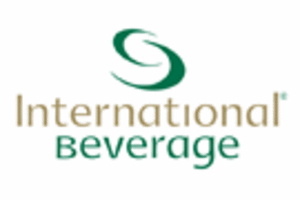
We export our brands to over 80 countries outside Thailand and our operations include distilleries in Scotland, China and across South East Asia.
International Beverage Holdings Limited (International Beverage) has been formed to be the international arm of Thai Beverage Public Company Limited (ThaiBev) and was established in 2005 to facilitate the continued expansion of the drinks business outside of Thailand.
Trivia:
- IB"s brand portfolio includes Chang beer, Mekhong Thai whisky, Sang Som liquor, Old Pulteney, Balblair, anCnoc and Speyburn single malts, Hankey Bannister, MacArthur"s, Catto"s and Drummer blended scotch whiskies, Caorunn gin, Old Pulteney and Heather Cream scotch liqueurs."
from International Beverage
The Owner: Thai Beverage Public Company
| Established: 2003 |
| Silent since: False |
| Address: 14 SangSom Building,Vibhavadee Rangsit Road, Chomphon,Chatuchak, Bangkok 10900 Thailand |
| → website |
White spirits are distilled liquors made from molasses without any mixture or color, and produced in four strengths of varying degrees of alcohol: 28, 30, 35 and 40% alcohol per volume. The company"s largest-selling white spirits are branded Ruang Khao or rice stalk. The labels are color-coded to reflect the alcoholic strength but do not have the brand name printed on them. Other brands in this category are Niyomthai and White Tiger.
ThaiBev produces brown and white spirits. Thai liquor is technically rum. Rum is derived from distilling cane juice, sugar or molasses until the product is with 60-95 degree alcohol content. The content is mixed with purified water to produce a satisfactory level of alcohol content before being transferred to age in charred oak barrels for at least one year. Before being bottled the liquor may be further mixed to adjust for desired color, aroma, and taste, but it has to have at least 40 degree alcohol content.
ThaiBev"s most famous, but not highest selling, liquor brand, Mekhong, originated in 1941 at the Bangyikhan Distillery west of Bangkok. Originally a state-owned distillery, it dates back over 200 years to the beginning of the current Chakri Dynasty. The launch of Mekhong was aimed at producing high-quality Thai liquor to stem the increase in the import of foreign liquor and to eventually replace imported brands. Sang Som however, has been the country"s most popular liquor brand for over 29 years, until 2006 holding almost 50% of the entire brown spirits market in Thailand. The company also produces Mungkorn Thong and Hong Thong and brands based on malt whisky, like Crown 99 and Blue, as well as Scottish whisky brands such as Hankey Banister and Pinwinnie Royal Scotch Whisky.
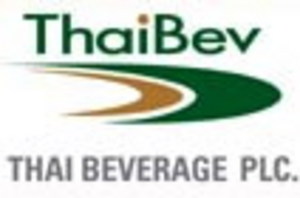
Thai Beverage (ThaiBev) is one of the largest beverage alcohol companies in South East Asia. Listed on the Singapore Stock Exchange, Thai Beverage Plc has a market capitalisation in excess of US$4bn.
Thai Beverage Public Company Limited owns and distributes a number of significant brands including Chang beer and Mekhong and Sang Som rum. Chang Beer, which first started production in March 1995 at the brewery in the district of Bang Ban, Ayutthaya Province, is the top-selling brand in Thailand. It managed to win 60% of market share in Thailand after a hard market fight with the previously biggest brand Singha. In 2006, the company"s market share was 49% of the beer market, according to research company Canadean.
"ThaiBev" was incorporated in Thailand in October 2003 in order to consolidate Thailand"s leading beer , spirits and non-alcohol businesses owned by the principal shareholders and their business associates under a single holding company.
from Wikipedia, ThaiBev.com
